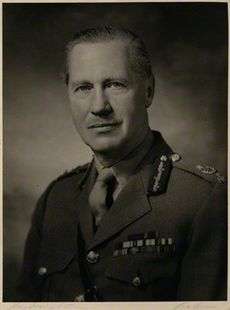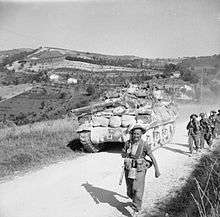Richard Hull
| Sir Richard Hull | |
|---|---|
 | |
| Born |
7 May 1907 Cosham, Hampshire |
| Died |
17 September 1989 (aged 82) Pinhoe, Devon |
| Allegiance | United Kingdom |
| Service/branch | British Army |
| Years of service | 1926–67 |
| Rank | Field Marshal |
| Unit | 17th/21st Lancers |
| Commands held |
Chief of the Defence Staff Chief of the General Staff Far East Land Forces British Troops in Egypt Staff College, Camberley 5th Infantry Division 1st Armoured Division 26th Armoured Brigade 12th Infantry Brigade 17th/21st Lancers |
| Battles/wars |
Second World War Indonesia–Malaysia confrontation |
| Awards |
Knight of the Order of the Garter Knight Grand Cross of the Order of the Bath Distinguished Service Order Mentioned in Despatches |
| Relations | Major General Sir Charles Hull (father) |
| Other work | Constable of the Tower of London (1970–1975) |
Field Marshal Sir Richard Amyatt Hull, KG, GCB, DSO, DL (7 May 1907 – 17 September 1989) was a senior British Army officer. He was the last Chief of the Imperial General Staff (1961–64) and the first Chief of the General Staff, and as such the professional head of the British Army. He later became Chief of the Defence Staff, the professional head of all the British Armed Forces. He served with distinction during the Second World War and later advised the British government on the response to the Indonesia–Malaysia confrontation.
Military career
Born the son of Major General Sir Charles Hull and Muriel Helen Hull (née Dobell),[1] and was educated at Charterhouse School and Trinity College, Cambridge,[2] Hull entered the Royal Military College, Sandhurst and was commissioned as a second lieutenant into the 17th/21st Lancers on 1 November 1926.[3] Posted with his regiment to Egypt in October 1928, he was promoted to lieutenant on 7 May 1931 and to captain on 1 June 1933 before going on to India in October 1933.[2]

After serving in the Directorate of Staff Duties at the War Office from February 1940, five months after the outbreak of the Second World War, Hull was appointed Officer Commanding (OC) C Squadron of his regiment in March 1941 and then Commanding Officer (CO) of the regiment in August 1941 before joining the staff of the 1st Canadian Armoured Division in June 1942.[4] He was given command of Blade Force, a unit based on the 17th/21st Lancers, in September 1942:[1] the unit landed in North Africa during Operation Torch and advanced at speed to Tebourba for which he was awarded the Distinguished Service Order on 11 February 1943.[5]
He then took command of the 12th Infantry Brigade in April 1943 and then 26th Armoured Brigade in North Africa in late 1943, being mentioned in despatches for services on 27 January 1944,[6] before becoming Deputy Director of Staff Duties at the War Office in December 1943.[4]
He became General Officer Commanding (GOC) 1st Armoured Division in Italy in August 1944, leading the division in the Italian Campaign through the fierce battles of Operation Olive on the Gothic Line;[1] he was checked by the Germans at Coriano.[4] Following the division's disbandment at the end of September, he became the commander of the 5th Infantry Division in November 1944, leading the division through the final phases of the campaign in North West Europe and, having been promoted to the substantive rank of major on 7 May 1945,[7] he was appointed a Companion of the Order of the Bath on 5 July 1945.[8]
Promoted to colonel on 13 April 1946,[9] he was appointed Commandant of Staff College, Camberley in May 1946, having been promoted again to major general on 13 June 1947,[10] he became Director of Staff Duties at the War Office in September 1948 and Chief Army Instructor at the Imperial Defence College on 1 January 1951.[11] He became Chief of Staff at headquarters Middle East Land Forces on 26 January 1953.[12] He was appointed GOC British Troops in Egypt on 15 June 1954[13] and, having been promoted to lieutenant general on 29 September 1954[14] and advanced to a Knight Commander of the Order of the Bath in the New Year Honours 1956,[15] he became Deputy Chief of the Imperial General Staff (DCIGS) on 5 October 1956.[16] He was appointed Commander in Chief Far East Land Forces on 25 June 1958[17] and, having been promoted to full general on 13 February 1959,[18] and advanced to Knight Grand Cross of the Order of the Bath in the Queen's Birthday Honours 1961,[19] he became Chief of the Imperial General Staff (CIGS) on 1 November 1961[20] (restyled Chief of the General Staff – CGS –in April 1964).[4] In this capacity he advised the British Government on the response to the Indonesia–Malaysia confrontation.[21] Having been promoted to field marshal on 8 February 1965,[22] he was appointed Chief of the Defence Staff (CDS) on 16 July 1965.[23] He retired from the British Army on 5 August 1967.[24]

He was also appointed Colonel of the 17th/21st Lancers from July 1947, Honorary Colonel of the Cambridge University Contingent from 30 May 1958[25] and Colonel Commandant of the Royal Armoured Corps from April 1968.[21]
In retirement he became a Non-Executive Director of Whitbread.[1] He was appointed Constable of the Tower of London from 1 August 1970,[26] Lord Lieutenant of Devon from 5 October 1978[27] and a Knight of the Order of the Garter on 23 April 1980.[28]
His interests included shooting, fly fishing and gardening; he knew every plant in his garden by their English, latin and local name.[1] He died of cancer at his home, Beacon Downe in Pinhoe on 17 September 1989.[1]
Family
In 1934 he married Antoinette Labouchére de Rougement; they had a son and two daughters.[2]
References
- 1 2 3 4 5 6 "Sir Richard Hull". Oxford Dictionary of National Biography. Retrieved 27 December 2011.
- 1 2 3 Heathcote, Anthony pg 180
- ↑ The London Gazette: no. 33222. p. 7479. 19 November 1926. Retrieved 27 December 2011.
- 1 2 3 4 Heathcote, Anthony pg 181
- ↑ The London Gazette: (Supplement) no. 35898. p. 744. 9 February 1943. Retrieved 27 December 2011.
- ↑ The London Gazette: (Supplement) no. 36349. p. 520. 25 January 1944. Retrieved 27 December 2011.
- ↑ The London Gazette: (Supplement) no. 37066. p. 2393. 4 May 1945. Retrieved 27 December 2011.
- ↑ The London Gazette: (Supplement) no. 37161. p. 3489. 3 July 1945. Retrieved 27 December 2011.
- ↑ The London Gazette: (Supplement) no. 37643. p. 3493. 5 July 1946. Retrieved 27 December 2011.
- ↑ The London Gazette: (Supplement) no. 37997. p. 2927. 24 June 1947. Retrieved 27 December 2011.
- ↑ The London Gazette: (Supplement) no. 39110. p. 49. 2 January 1951. Retrieved 27 December 2011.
- ↑ The London Gazette: (Supplement) no. 39776. p. 883. 10 February 1953. Retrieved 27 December 2011.
- ↑ The London Gazette: (Supplement) no. 40278. p. 5311. 14 September 1954. Retrieved 27 December 2011.
- ↑ The London Gazette: (Supplement) no. 40346. p. 6979. 7 December 1954. Retrieved 27 December 2011.
- ↑ The London Gazette: (Supplement) no. 40669. p. 3. 30 December 1955. Retrieved 27 December 2011.
- ↑ The London Gazette: (Supplement) no. 40893. p. 5615. 2 October 1956. Retrieved 27 December 2011.
- ↑ The London Gazette: (Supplement) no. 41429. p. 4045. 24 June 1958. Retrieved 27 December 2011.
- ↑ The London Gazette: (Supplement) no. 41655. p. 1719. 10 March 1959. Retrieved 27 December 2011.
- ↑ The London Gazette: (Supplement) no. 42370. p. 4145. 2 June 1961. Retrieved 27 December 2011.
- ↑ The London Gazette: (Supplement) no. 42503. p. 7925. 31 October 1961. Retrieved 27 December 2011.
- 1 2 Heathcote, Anthony pg 182
- ↑ The London Gazette: (Supplement) no. 43569. p. 1361. 5 February 1965. Retrieved 27 December 2011.
- ↑ The London Gazette: (Supplement) no. 43712. p. 6717. 13 July 1965. Retrieved 27 December 2011.
- ↑ The London Gazette: (Supplement) no. 44376. p. 8436. 28 July 1967. Retrieved 27 December 2011.
- ↑ The London Gazette: (Supplement) no. 41398. p. 3365. 27 May 1958. Retrieved 27 December 2011.
- ↑ The London Gazette: no. 45163. p. 8587. 4 August 1970. Retrieved 27 December 2011.
- ↑ The London Gazette: no. 47659. p. 11997. 9 October 1978. Retrieved 27 December 2011.
- ↑ The London Gazette: (Supplement) no. 48167. p. 6159. 25 April 1980. Retrieved 27 December 2011.
Further reading
- Heathcote, Tony (1999). The British Field Marshals 1736–1997. Barnsley (UK): Pen & Sword. ISBN 0-85052-696-5.
| Military offices | ||
|---|---|---|
| Preceded by Alexander Galloway |
General Officer Commanding 1st Armoured Division August 1944 – September 1944 |
Succeeded by Post Disbanded |
| Preceded by Philip Gregson-Ellis |
General Officer Commanding the 5th Division 1944–1946 |
Succeeded by Philip Gregson-Ellis |
| Preceded by Philip Gregson-Ellis |
Commandant of the Staff College, Camberley 1946–1948 |
Succeeded by Alfred Dudley Ward |
| Preceded by Lewis Lyne |
Director of Staff Duties, War Office 1948–1950 |
Succeeded by Edric Bastyan |
| Preceded by Sir Francis Festing |
General Officer Commanding the British Troops in Egypt 1954–1956 |
Post disbanded |
| Preceded by Sir Alfred Ward |
Deputy Chief of the Imperial General Staff 1956–1958 |
Succeeded by Sir Harold Pyman |
| Preceded by Sir Francis Festing |
C-in-C Far East Land Forces 1958–1961 |
Succeeded by Sir Nigel Poett |
| Preceded by Sir Francis Festing |
Chief of the Imperial General Staff 1961–1964 |
Succeeded by Post abolished |
| Preceded by New post |
Chief of the General Staff 1964–1965 |
Succeeded by Sir James Cassels |
| Preceded by The Viscount Mountbatten of Burma |
Chief of the Defence Staff 1965–1967 |
Succeeded by The Lord Elworthy |
| Honorary titles | ||
| Preceded by Sir Gerald Templer |
Constable of the Tower of London 1970–1975 |
Succeeded by Sir Geoffrey Baker |
| Preceded by The Lord Roborough |
Lord Lieutenant of Devon 1978–1982 |
Succeeded by The Earl of Morley |
